
South America: Galapagos Inner Loop Cruise - 2025
Celebrity Cruises
In the Galapagos, modern explorers come eye to eye with ancient tortoises, comical birds, and other amazing beasts — plus landscapes as fantastical as the animals — for a once-in-a-lifetime adventure. For seven glorious days, you'll follow in the footsteps of Darwin, viewing this realm through the eyes of certified naturalists, in small groups of travelers who share your interests.

Executive Member Benefit
Executive Members receive an annual 2% Reward, up to $1,250, on qualified Costco Travel purchases
Digital Costco Shop Card
Member Exclusive: Digital Costco Shop Card with every Celebrity Cruises sailing†
Sailing Itinerary

Note: Cruise itineraries are subject to change. Please verify ports and times directly with the cruise line.
Overview
Baltra, also referred to as South Seymour Island, is one of the smaller islands of the Galapagos, with an area of roughly 8 square miles. The island lies in the Eastern Pacific Ocean, about 600 miles west of Ecuador. The significance of Baltra rests in the fact that it is the main entry point into the Galapagos Islands. The main airport of the archipelago is located on Baltra (a second smaller one is in San Cristobal). Before Volcanic faulting occurred, Baltra was part of Santa Cruz, making it the newest of the islands. Due to its small size, there are no visitor accommodations in Baltra. Though the island is dry and the vegetation desolate, a large number of birds-frigatebirds and boobies- can be seen at the harbor. Land iguanas, marine iguanas, and marine turtles can also be observed. After you arrive at Baltra, take the time to visit Bachas Beach, where you will be introduced to the wonders of the Galapagos. Also, don’t miss the chance to take a panga ride through Black Turtle Cove and enjoy the beauty of the surrounding mangroves.
Overview
A visit to Puerto Egas begins with a wet landing on the dark sand beaches of James Bay. The visit begins with a walk along the rocky coast allowing visitors to view some of the Galapagos Island's best tide pools. Sponges, snails, hermit crabs, barnacles, and fish including the endemic four-eyed blenny can be seen. The walk also presents visitors with a variety of shore birds, marine iguanas, sally light foot crabs,s and sea lions.There are t interesting excursions normally visited from Puerto Egas. The first is a short walk from the landing site bringing visitors to the site of one of the Galapagos' first entrepreneurial endeavors. For decades salt was extracted from a local salt crater. The industry was abandoned in the 1950's leaving behind a variety of rusted old machines and parts of buildings. The trail follows the path once used by wagon trains to the crater cone.The second excursion begins just a short distance beyond the tide pools is the fur seal grotto. Fur Seals and Sea Lions can be seen swimming in the rocky lava-ringed pools. This may be the only opportunity visitors have to see and swim with fur seals.Fur seals were once hunted to near extinction for their coats. The Galapagos Fur Seal is the smallest of the Fur Seals found in the Southern Hemisphere, now compared in numbers with the sea lions. During the day they hide from the hot equatorial sun in shelves or caves of the rocky lava cliffs. At night they feed on squid and fish avoiding the sharks, which are their natural predator.The crystal clear water, volcanic bridges, fur seals, and sea lions make this a magnificent place for swimming and snorkeling.
Overview
Located just south of Santiago Island, Rabida, also known as Jervis Island, is a small island just over 2 km in width and 400 meters above sea level at its highest point. It is one of the most volcanically varied islands in the Galapagos. This small island geologically consists of eroded hills and lava emitted from spatter cones that have resulted in the island's striking colors. The reddish beach and steep volcanic slopes give this island a distinctive look. Rabida is home to a variety of exotic animals. Marine Iguanas, ancestors of the controversial land iguanas, are a common site on the beaches of Rabida. Noisy Sea Lions are often seen resting in the shade of the caves nearby. The saltwater lagoon of Rabida is the feeding place for Flamingos, Bahama pintail ducks, and Common Stilts; and the nesting site for Brown Pelicans. This island may be the only place where visitors have the opportunity to observe brown pelicans nesting up close. When on the island, visitors can take a short trail inland in search of Galapagos wildlife. Finches, doves, yellow warblers, s and mockingbirds are just a feather few bird species one can expect to encounter while exploring Rabida. Vegetation on the island consists mainly of opuntia cactus, palo santo trees, and scrubby bushes. Once finished with land exploration, visitors to Rabida can indulge in the beauty of the surrounding waters. The marooned beach offers grand swimming and snorkeling opportunities with an almost guaranteed chance to witness sharks and manta rays in the sparkling waters.
Overview
An extremely interesting area for its prolific mangrove Eco-system and its marine life of many different forms. It is a spectacular place for snorkeling and dinghy rides. The species more commonly seen are penguins, flightless cormorants, herons and Blue-footed boobies.
Overview
Tagus Cove is situated directly east of Fernandina on the west coast of Isla Isabela. It is a beautifully well-protected cove sheltered by the shoulders of two volcanic craters and has been used as an anchorage for over 300 years. This was a favorite site of pirates and early whalers, who left their ship names and historical graffiti carved on the high cliff. You can go ashore and visit a saltwater lagoon and the lava fields of Darwin Volcano. You will also have magnificent views over the ocean. Go along the cliffs with a launch and see the exclusive Galapagos penguins, the flightless cormorants, and many other sea birds.
Overview
On the east side of Santiago island sits yet another body of water, Sullivan Bay, famous for its conelike volcano and various types of lava rock which have been studied by many for years. The glazed black lava rock of this eastern bay has been so well preserved that, at times it may seem as if the lava is still in a molten state.
Overview
Bartolome, the star island of the Galapagos, is located to the east of Santiago Island facing Sullivan Bay. It is the most photographed island in the chain due to its 350 ft. summit and its magnificent view, which creates a tropical landscape panorama. The moonlike landscape is riddled with different formations of volcanic rock including lava flows and lava tubes. Bartolome is an island full of exploration and adventure. After a 60-meter hike, visitors can take in the Pinnacle Rock, one of the best-known landmarks in the archipelago. Remains of volcanic ash particles have created with time this large formation, which rises 70 meters above a nearby cove. Near the base of the statuesque pinnacle rock, you can see a large variety of multi-colored fish, sea lions, and indigenous Galapagos penguins, which can be seen while snorkeling or swimming in the surrounding waters of Bartolome. This little animal has the northernmost range of any other species of penguin. This penguin is prevalent in this area as there are around 2500 pairs. Another one of the many amazing animals that may be encountered on this island is the Great Blue Heron. The foliage behind the beach consists of the red and white mangrove, saltbush, morning glory, and prickly pear cactuses. Between January and March, visitors may catch a glimpse of different species of sea turtles as they lay their eggs on the beach. Visitors to Bartolome may take a walk through mangroves where mating sea turtles andwhite-tippedd sharks are commonplace.
Overview
Located to the west of Black Turtle Cove on Santa Cruz Island, its sand is made of decomposed coral, which makes it white and soft. These islands are the favorite nesting for sea turtles.
Overview
One of the central islands, Daphne lies north of Santa Cruz and west of Baltra. There are two islands Daphne Major and Daphne Minor. Daphne Major is the younger of the two and the one that is visited. Though its location is easily in reach for most cruises, it is a select few that can visit this special place. The National Park Service restricts visitors allowed to visit Daphne. Visits are only allowed under a special written permit by the National Park. Many boats cruise by close enough to view the many birds and sea lions that live on Daphne. It is also a popular dive site for local dive operators from Santa Cruz.
Overview
North Seymour Island, also referred to as Seymour is a small island to the North of Baltra. This island was formed years ago as a result of the uplift of a submarine lava formation. Because of the circumstances under which the island took shape, North Seymour consists of mostly flat, llow-lyingterrain. The vegetation on North Seymour, like many of the other lava-formed islands of the Subtropic, is mainly low and bushy. North Seymour’s signature feature is its enormous colony of Darwin’s magnificent frigate birds. The population of frigates is larger here than anywhere else in the Galapagos chain. The frigates can be found nesting mostly on the southwest side of the island due to the prime nesting conditions. Many other birds can be encountered on North Seymour such as the Blue Footed Boobies, Swallow-tailed Gulls, pelicans, and Red-billed Tropic birds. Visitors to the island might also catch a glimpse of the amazing Galapagos snake. North Seymour’s coast is a bit more tumultuous than that of some of the other islands in the Galapagos. Despite this fact, many playful sea lions can be found sprawled on the beach along with marine iguanas, one of the most controversial of the Galapagos’ amazing creatures.
Overview
The capital of Galapagos, Puerto Baquerizo Moreno, is located on San Cristobal Island. The administration offices, one airport linking to the mainland, and a major Ecuadorian Navy facility are located here. Founded by the colonist General Villamil in the mid-nineteenth century, Puerto Baquerizo Moreno was named after Alfredo Baquerizo Moreno, the first Ecuadorian president to visit the islands, in 1916. Despite being the capital of the Galapagos, it's a sleepy town, virtually lifeless in the heat of the early afternoon, only coming alive fully when the sun sets over the bay. It may not get as many visitors as Puerto Ayora, but there is a burgeoning industry here: along the waterfront, a glut of travel agents, cafes, restaurants, and souvenir shops all show a town keen to cut itself a larger slice of the tourist pie. Puerto Baquerizo Moreno is a bit short of things to do, but there's enough on the island to keep visitors busy for a few days. Just outside the port, the Centro de Interpretación has great displays of the archipelago's human and natural history. Puerto Baquerizo Moreno has also become the focus of thGalapago'sos growing reputation among South Americans as a surfing hotspot, and the waves are best at the beginning of the warm-wet season when the water is warm enough not to need a wet suit. Tongo Reef, west of town, is one of the better places to go for this.
Overview
Located on the northwest side of San Cristobal Island. The main attraction of Pitt Point is that it is the only place in the Galapagos where you can find three species of booby birds nesting in the same zone. In addition, the beautiful scenery from the top of the pathway is important, with the view of the bay toward one side and the cliffs on the other.
Overview
The largest settlement area, offering the most services in the Galapagos, Puerto Ayora is a port town situated along Academy Bay on Isla Santa Cruz. Most yachts offering cruises of the Galapagos hail from Puerto Ayora. Also home to the National Park Services and the Charles Darwin Research Station, it is the hub of tourism in the islands.Puerto Ayora is far from the bustling cities on the mainland. The bay is full of sailboats, sea birds fill the air, and marine iguanas line the shore. Though a thriving center of commerce people enjoy a laid-back island attitude. Most travelers to the Galapagos will include a visit to Puerto Ayora during their trip. Most cruises include a visit to the Darwin Station and arrange free time to explore the town and shop for souvenirs. This may be the only opportunity for a souvenir shop in the islands. Stores carry everything from t-shirts to jewelry, postcards, books, beachware, and ceramic items. The grocery store offers the opportunity to stock up on any forgotten items, snacks, beverages, or other items you might desire on board. If you need additional money, the Banco del Pacifico offers cash advances on Master Card. They also offer a Cirrus ATM, though it does not always work.Puerto Ayora offers options for visitors who prefer to sleep ashore or extend their stay in the islands. There are a variety of tours available allowing visitors to design their own Galapagos experience including day trips to a number of the islands, dive trips, kayaking, highland tours, hiking, mountain biking, and horseback rides.
Overview
Baltra, also referred to as South Seymour Island, is one of the smaller islands of the Galapagos, with an area of roughly 8 square miles. The island lies in the Eastern Pacific Ocean, about 600 miles west of Ecuador. The significance of Baltra rests in the fact that it is the main entry point into the Galapagos Islands. The main airport of the archipelago is located on Baltra (a second smaller one is in San Cristobal). Before Volcanic faulting occurred, Baltra was part of Santa Cruz, making it the newest of the islands. Due to its small size, there are no visitor accommodations in Baltra. Though the island is dry and the vegetation desolate, a large number of birds-frigatebirds and boobies- can be seen at the harbor. Land iguanas, marine iguanas, and marine turtles can also be observed. After you arrive at Baltra, take the time to visit Bachas Beach, where you will be introduced to the wonders of the Galapagos. Also, don’t miss the chance to take a panga ride through Black Turtle Cove and enjoy the beauty of the surrounding mangroves.
Onboard the Celebrity Flora
Celebrity Flora
Year Built: 2018
Double Occupancy Capacity: 100
Celebrity Flora® marks an evolutionary turning point in the approach to ship design—creating a sense of being truly immersed in the destination, instead of just visiting it. Indulge in the largest and most luxurious accommodations in the Galapagos Islands, where every stateroom on board is a suite. Dine on delectable menus, curated by a Michelin-starred chef, and allow your Personal Suite Attendant to help you unpack. All this to ensure that your visit to these primitive islands is anything but.
Activities & Services (included in cruise)

Observatory
- Fitness Center
- Sauna/Steam Room
- Water Sports Platform
- Whirlpool/Jacuzzi
- Bars/Lounges
- Library
- Concierge Desk
- Elevators
- Safe Deposit Boxes
Activities & Services (available for an extra fee)

Jacuzzi
- Full-Service Spa
- Dry Cleaning/ Laundry Service
- Duty-Free Shops/Boutiques

Seaside Restaurant
Main Dining
Seaside Restaurant: Experience a culinary journey in the Galapagos in the Seaside Restaurant. It's a spacious "barefoot chic" space that features destination-inspired design elements and floor-to-ceiling windows throughout for stunning vistas that complement the mouthwatering meals you'll enjoy here—morning, noon, and night.

Ocean Grill
Casual Dining
Ocean Grill Restaurant: Ocean Grill is an outdoor casual restaurant that offers panoramic views during the day and stunning, starlit skies at night. Here, there's every opportunity to enjoy both the destination and our culinary expertise daily. From grilling up the highest quality, sustainable seafood from the area for lunch to what we like to call Dinner Under the Stars, Ocean Grill is the envy of any destination restaurant around.
Suites feature a private balcony, complimentary sparkling wine, use of snorkel equipment and wetsuits, and much more.
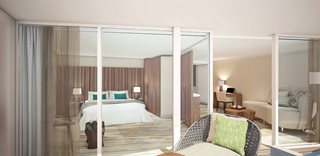
Category: W
This category can be booked for a special rate, guaranteed to you. Please note that the category is not associated at the time of booking with a specific stateroom, deck, bedding configuration or other particular settings. The assignment of an actual cabin will be performed during your check-in. The cabin can be anywhere on the ship.
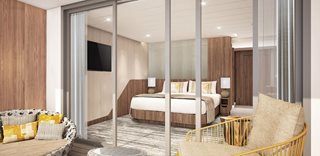
Category: S1
Amenities- Complimentary premium refillable water bottle
- Daily delivery in-suite delectable
- Customized mini-bar offering
- Champagne / sparkling wine upon arrival
- Complimentary backpack
- Complimentary rain poncho
- Stationery
- Use of high-end marine binoculars
- Ecuadorian chocolates
- Use of sunglasses and readings glasses
- Local high-end, eco-friendly, organic bath amenities cooling gel, lip balm, sunscreen
- Spacious veranda
- Outward facing design
- King-sized bed
- Spacious shower
- Full Suite automation
- Double faucet vanity with stone countertop
- In-suite filtered water refilling station
- Premium linens and pillow menu
- Extensive offering of live and on demand TV programming and movies
- Personal Suite Attendant
- Laundry service twice per sailing
- 24-hour in suite room service
- Full in-suite dinner service
- Laundry service twice per sailing*
- Makeup and turndown services
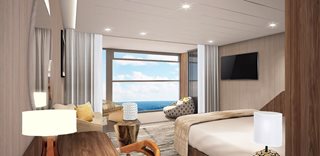
Category: SK
Amenities- Complimentary premium refillable water bottle
- Daily delivery in-suite delectable
- Customized mini-bar offering
- Champagne / sparkling wine upon arrival
- Complimentary backpack
- Complimentary rain poncho
- Stationary
- Use of high-end marine binoculars
- Ecuadorian chocolates
- Use of sunglasses and readings glasses
- Local high-end, eco-friendly, organic bath amenities cooling gel, lip balm, sunscreen
- Outward-facing design
- Infinite Veranda
- King-sized bed
- Spacious shower
- Full Suite automation
- In-suite filtered water refilling station
- Premium linens and pillow menu
- Double-faucet vanity with stone countertop
- Extensive offering of live and on demand TV programming and movies
- Personal Suite Attendant
- 24-hour in-suite room service
- Full in-suite dinner service
- Makeup and turndown services
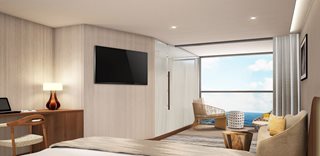
Category: SP
Amenities- Complimentary premium refillable water bottle
- Daily delivery in-suite delectable
- Customized mini-bar offering
- Champagne / sparkling wine upon arrival
- Complimentary backpack
- Complimentary rain poncho
- Stationery
- Use of high-end marine binoculars
- Ecuadorian chocolates
- Use of sunglasses and readings glasses
- Local high-end, eco-friendly, organic bath amenities cooling gel, lip balm, sunscreen
- Outward-facing spacious spa tub and shower
- Infinite Veranda
- King-sized bed
- Full Suite automation
- In-suite filtered water refilling station
- Premium linens and pillow menu
- Extensive offering of live and on demand TV programming and movies
- Personal Suite Attendant
- Laundry service twice per sailing
- 24-hour in-suite room service
- Full in-suite dinner service
- Laundry service twice per sailing
- Makeup and turndown services

Category: SU
Amenities- Complimentary premium refillable water bottle
- Daily delivery in-suite delectable
- Customized mini-bar offering
- Champagne / sparkling wine upon arrival
- Complimentary backpack
- Complimentary rain poncho
- Stationery
- Use of high-end marine binoculars
- Ecuadorian chocolates
- Use of sunglasses and readings glasses
- Local high-end, eco-friendly, organic bath amenities cooling gel, lip balm, sunscreen
- Outward-facing spacious spa tub and shower
- Infinite Veranda
- King-sized bed
- Private refrigerator
- In-suite safe
- Full Suite automation
- In-suite filtered water refilling station
- Premium linens and pillow menu
- Extensive offering of live and on demand TV programming and movies
- Personal Suite Attendant
- Laundry service twice per sailing
- 24-hour in-suite room service
- Full in-suite dinner service
- Laundry service twice per sailing
- Makeup and turndown services

Category: RS
Amenities- Robes with optional personalization
- Complimentary premium refillable water bottle
- Daily delivery in-suite delectable
- Customized mini-bar offering
- Champagne / sparkling wine upon arrival
- Complimentary backpack
- Complimentary rain poncho
- Stationery
- Use of high-end marine binoculars
- Ecuadorian chocolates
- Use of sunglasses and readings glasses
- Local high-end, eco-friendly, organic bath amenities cooling gel, lip balm, sunscreen
- Outward-facing spacious spa tub and shower
- King-sized bed
- Spa tub with floor-to-ceiling window
- Separate shower
- Spacious private veranda
- Full Suite automation
- In-suite filtered water refilling station
- Premium linens and pillow menu
- Extensive offering of live and on demand TV programming and movies
- Personal Suite Attendant
- Laundry service twice per sailing*
- 24-hour in suite room service
- Full in-suite dinner service
- Laundry service twice per sailing
- Makeup and turndown services
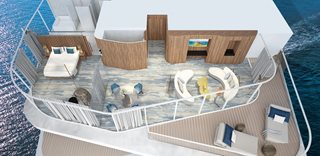
Category: PS
Amenities- Robes with optional personalization
- Complimentary premium refillable water bottle
- Daily delivery in-suite delectable
- Customized mini-bar offering
- Champagne / sparkling wine upon arrival
- Complimentary backpack
- Complimentary rain poncho
- Stationery
- Use of high-end marine binoculars
- Ecuadorian chocolates
- Use of sunglasses and readings glasses
- Local high-end, eco-friendly, organic bath amenities cooling gel, lip balm, sunscreen
- Largest, most luxurious suite in the Galápagos Islands
- Outward-facing spacious spa tub and shower
- King-sized bed
- Additional half bathroom
- Wraparound floor-to-ceiling windows
- Spa tub with floor-to-ceiling window
- Separate shower
- Spacious private veranda
- Full Suite automation
- In suite filtered water refilling station
- Premium linens and pillow menu
- Extensive offering of live and on demand TV programming and movies
- Personal Suite Attendant
- Laundry service twice per sailing*
- 24-hour in suite room service
- Full in-suite dinner service
- Laundry service twice per sailing
- Makeup and turndown services

Category: SL
Amenities- Complimentary premium refillable water bottle
- Daily delivery in-suite delectable
- Customized mini-bar offering
- Champagne / sparkling wine upon arrival
- Complimentary backpack
- Complimentary rain poncho
- Stationary
- Use of high-end marine binoculars
- Ecuadorian chocolates
- Use of sunglasses and readings glasses
- Local high-end, eco-friendly, organic bath amenities cooling gel, lip balm, sunscreen
- Outward-facing design
- Infinite Veranda
- King-sized bed
- Spacious shower
- Full Suite automation
- In-suite filtered water refilling station
- Premium linens and pillow menu
- Double-faucet vanity with stone countertop
- Extensive offering of live and on demand TV programming and movies
- Personal Suite Attendant
- 24-hour in-suite room service
- Full in-suite dinner service
- Makeup and turndown services

Category: S2
Amenities- Complimentary premium refillable water bottle
- Daily delivery in-suite delectable
- Customized mini-bar offering
- Champagne / sparkling wine upon arrival
- Complimentary backpack
- Complimentary rain poncho
- Stationery
- Use of high-end marine binoculars
- Ecuadorian chocolates
- Use of sunglasses and readings glasses
- Local high-end, eco-friendly, organic bath amenities cooling gel, lip balm, sunscreen
- Spacious veranda
- Outward facing design
- King-sized bed
- Spacious shower
- Full Suite automation
- Double faucet vanity with stone countertop
- In-suite filtered water refilling station
- Premium linens and pillow menu
- Extensive offering of live and on demand TV programming and movies
- Personal Suite Attendant
- Laundry service twice per sailing
- 24-hour in suite room service
- Full in-suite dinner service
- Laundry service twice per sailing*
- Makeup and turndown services

Category: S3
Amenities- Complimentary premium refillable water bottle
- Daily delivery in-suite delectable
- Customized mini-bar offering
- Champagne / sparkling wine upon arrival
- Complimentary backpack
- Complimentary rain poncho
- Stationery
- Use of high-end marine binoculars
- Ecuadorian chocolates
- Use of sunglasses and readings glasses
- Local high-end, eco-friendly, organic bath amenities cooling gel, lip balm, sunscreen
- Spacious veranda
- Outward facing design
- King-sized bed
- Spacious shower
- Full Suite automation
- Double faucet vanity with stone countertop
- In-suite filtered water refilling station
- Premium linens and pillow menu
- Extensive offering of live and on demand TV programming and movies
- Personal Suite Attendant
- Laundry service twice per sailing
- 24-hour in suite room service
- Full in-suite dinner service
- Laundry service twice per sailing*
- Makeup and turndown services

| Symbol | Description |
|---|

- Ship Name: Celebrity Flora
- Year Built: 2018
- Year Entered Present Fleet: 2019
- Ship Class: Expedition Series
- Maximum Capacity: 100
- Number of Passenger Decks: 6
- Number of Crew: 70
- Tonnage (GRT): 5,739
- Capacity Based on Double Occupancy: 100
- Country of Registry: Ecuador
- Total Staterooms: 50
- Suites with Balcony: 50
Costco Member Reviews

Available Dates & Prices
Terms & Conditions
*Price shown is per person based on double occupancy and is valid for select stateroom categories only. Click on the Terms & Conditions link below for details.
†One Digital Costco Shop Card per room/stateroom, per stay. The exact amount of the Digital Costco Shop Card will be calculated during the booking process. The Digital Costco Shop Card promotion is nontransferable and may not be combined with any other promotion. A Digital Costco Shop Card will arrive by email approximately 10 days after the start of your cruise. Click on the Terms & Conditions link below for additional information.
Ship's registry: Ecuador
Digital Costco Shop Card
This booking includes a Digital Costco Shop Card which will arrive by email one to two weeks after you return from your vacation. The Digital Costco Shop Card is a convenient payment option in our warehouses and on Costco.ca.




















